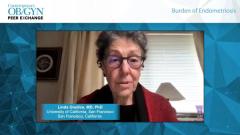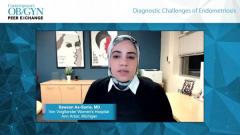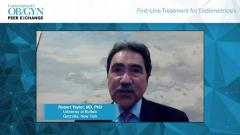
Endometriosis Treatment Approach
Endometriosis experts describe the considerations of selecting a therapy for patients who are suffering from endometriosis.
Episodes in this series

Hugh Taylor, MD: Susie, do customize your first-line therapy based on the type of endometriosis or the location of the lesion?
Sawsan As-Sanie, MD: Like everyone here, I definitely think shared decision-making is going to be really important. In our referral practice, it’s pretty rare that I see patients who’ve never tried anything before. That might be a different population from what’s seen in an adolescent clinic or in providers who are more primary care. Understanding what a patient has tried previously, what they’ve tolerated and not tolerated, is going to guide my decision-making. As several of you mentioned, progestin, an oral progesterone, is often my first go-to for a couple of reasons. In some of the expert literature, it’s the preferred treatment for patients with deeply infiltrative endometriosis and bowel endometriosis. Patients who aren’t having surgery, in my reading, tend to be a bit more favored for progestin-only treatments.
Some of the nuances are in patients who have ovarian endometriomas. It’s not that I won’t use a leave-in gestural IUD [intrauterine device], but I will often have them on dual suppression. Because we know that the leave-in a gestural IUD doesn’t consistently suppress ovulation, and ovulation is thought to be at least 1 of the mechanisms of the pathophysiology of ovarian endometriomas. I’d want them on something with systemic or ovarian suppression as well. Those would be some of the spaces where I have a more nuanced, selective treatment for that type of endometriosis. Otherwise, there’s very little comparative data between different methods. What a patient prefers, what they’ve tried before, and what adverse effects they’ve had will definitely be strong factors for what I select.
Hugh Taylor, MD: I find it the same as you described. The levonorgestrel-releasing intrauterine system is great for dysmenorrhea—it reduces menstrual flow, reduces menstrual cramping—but not as good for some of the systemic or remote effects of endometriosis. I’d prefer dual therapy as well.
Sawsan As-Sanie, MD: Although it’s off-label to use dual therapy, the potential benefit of it is that you can get close to or achieve amenorrhea, and you need to give only lower doses of an oral hormone to suppress ovulation. Whereas in some patients, if you have a very low dose of an oral medication, then you’re going to continue to titrate up their dose to achieve the goal of amenorrhea as well as ovarian suppression. For patients who don’t tolerate higher doses of norethindrone acetate, which is probably the most common progestin I use, having those dual actions can be really helpful.
Hugh Taylor, MD: Jessica, do you use some of the newer IUDs—some of the smaller ones—especially in the younger patients you see?
Jessica Shim, MD: No, not necessarily. I find that the majority of patients still have a uterine depth or length that can accommodate the 52-mg levonorgestrel intrauterine devices. I still feel I can often use the 52-mg ones. We do find, though, that many of our patients have never been sexually active or are nulliparous, so they’re not likely to tolerate a pelvic exam. One way we offer IUDs is by placing them at the time of laparoscopy, which patients really enjoy. To your point, Susie, about the dual suppression, there’s a retrospective cohort study that assessed adolescents using the IUD. [The investigators] found that at least two-thirds of them required something in addition to the IUD. That’s a very frank discussion that my colleagues and I have with our adolescents. We say, “The IUD is a great contraceptive that you can get placed, but you’ll probably need to be on something else on top of it to maximize benefit.”
Hugh Taylor, MD: Absolutely. Rob, does anybody still use danazol?
Robert Taylor, MD, PhD: There’s been some recent interest from Italy about a danazol-loaded IUD. There were some early results from Japan a decade or 2 ago using a danazol IUD, in an attempt to avoid some of the major systemic effects but deliver an androgen/progestin to the endometrium in the local pelvic environment. When the GNRH agonists became available, most of the patients I manage who had been on danazol previously were happy to accept the adverse effects of the GNRH super agonists. We now know those are pretty hefty adverse effects. I don’t think we’re going to see a lot more danazol, unless it comes in some very interesting delivery mode. An IUD might work. But I don’t think we’ll go back to systemic danazol very much.
Hugh Taylor, MD: I have a few patients who like it. It’s quite effective. I start with a progestin oral contraceptive, and I have a few who had significant mood effects from that and couldn’t tolerate the progestins. In the old days, when the next choice was something that was an injectable drug with significant adverse effects, some of them chose danazol and wanted to remain on it. Although the incidence of acne and hair growth is real, many patients don’t get those adverse effects and do very well on danazol. It’s something we’ve forgotten, but occasionally I find a patient who wants it and does well on it.
Robert Taylor, MD, PhD: Jessica mentioned transgender patients who might be on testosterone and may have a history of endometriosis or are suspicious of endometriosis. I’m curious: in that patient population, do you see any benefit to testosterone therapies?
Jessica Shim, MD: As far as being on testosterone, patients could still experience dysmenorrhea symptoms, and we’re in that evaluation. We know that testosterone doesn’t achieve amenorrhea 100% of the time. We know that quite a bit of unscheduled bleeding and pelvic pain can occur despite testosterone. But I like using danazol for a lot of our transgender and gender-diverse patients. Those on testosterone require a little added menstrual suppression. [I also like it] for patients who haven’t been on gender-affirming hormone therapy. Many patients who don’t tolerate progesterone therapies or who have adverse effects or concerns using estrogen-containing therapies often like danazol as an alternative.
Robert Taylor, MD, PhD: Occasionally, I’ve had patients complain of low libido after reading about danazol and wanted to try it for that reason as well.
Hugh Taylor, MD: That still maybe an issue.
Linda Giudice, MD, PhD: I’ve occasionally used danazol vaginally for patients. It’s anecdotal, and it’s a last resort. But for some patients with rectovaginal disease, having the vaginal delivery of danazol has seemed to work.
Robert Taylor, MD, PhD: Another point is that danazol is not aromatizable. That may be an advantage over some of the other antigens.
Hugh Taylor, MD: Absolutely.
TRANSCRIPT EDITED FOR CLARITY
Newsletter
Get the latest clinical updates, case studies, and expert commentary in obstetric and gynecologic care. Sign up now to stay informed.

























